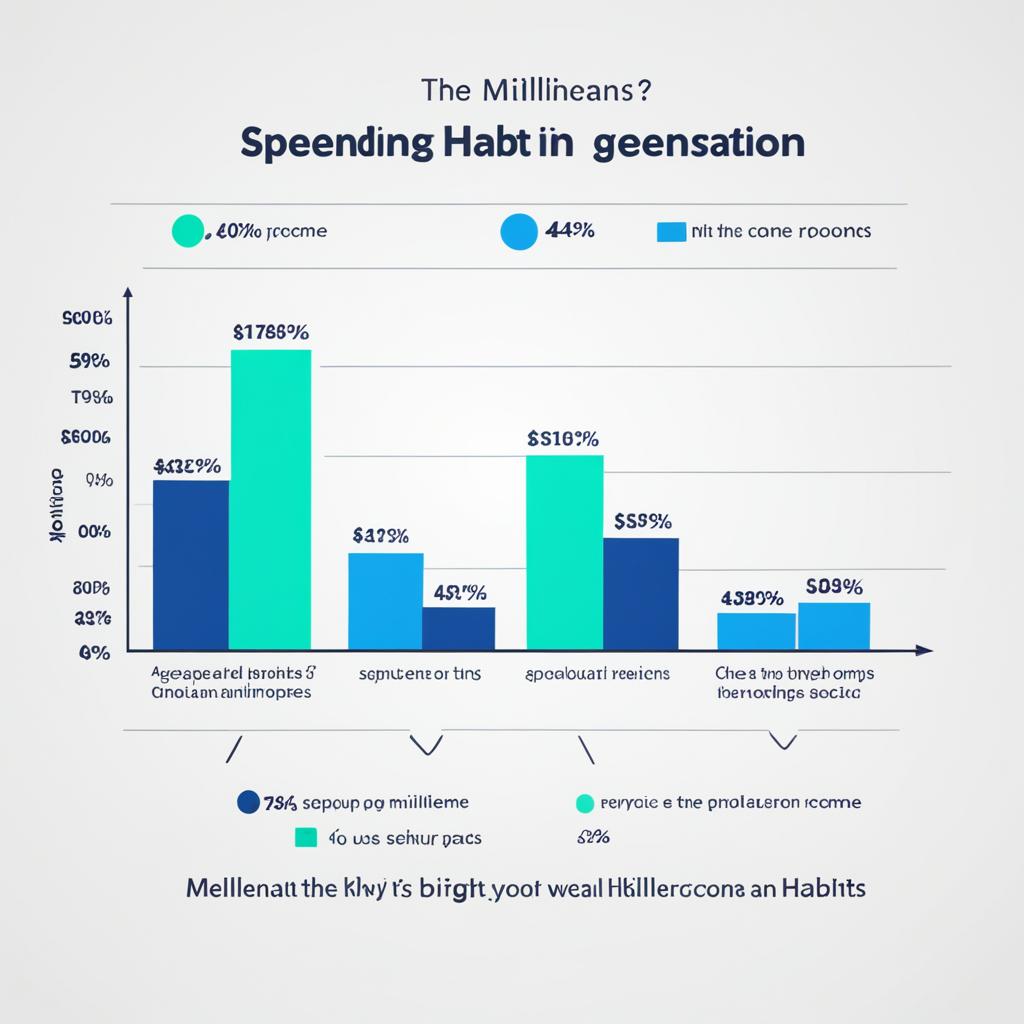As a millennial, I understand the unique challenges we face when it comes to managing our money. From the burden of student loan debt to rising living costs, it can be tough to navigate our financial landscape. But despite these challenges, millennials have distinct spending habits that set us apart from previous generations. In this article, we will delve into the fascinating world of millennial consumer behavior, exploring how we prioritize experiences, socially responsible brands, and convenience.
Key Takeaways
- Millennials tend to spend more on experiences like travel and dining out.
- They prioritize socially responsible brands that align with their values.
- Student loan debt hinders millennials’ ability to save and purchase homes.
- Despite financial challenges, millennials have an average savings rate of 9.8%.
- Understanding millennial spending habits is essential for businesses and marketers in today’s market.
Who are Millennials?
Millennials, also known as Generation Y, are the generation that falls between Generation X and Generation Z. They were born between 1981 and 1996 and are the largest age group in the United States, consisting of 72.2 million individuals. Notably, millennials make up the most educated generation, with one-third of them holding at least a bachelor’s degree.
Millennials, or Gen Y, are the generation between Gen X and Gen Z. They were born to Baby Boomers and early Gen Xers, and they are defined as people born between 1981 and 1996. With a population of 72.2 million, millennials are the largest age group in the US. They are also recognized as the most educated generation, with one-third of them possessing at least a bachelor’s degree.
Millennials, often referred to as Gen Y, occupy the space between Generation X and Generation Z. Born to Baby Boomers and early Gen Xers, millennials were born between 1981 and 1996. With a staggering 72.2 million individuals, they form the largest age group in the United States. Additionally, millennials boast the highest level of education among all generations, with one-third of them holding at least a bachelor’s degree.
“Millennials, or Gen Y, are the generation between Gen X and Gen Z, born to Baby Boomers and early Gen Xers.”
Millennials, also known as Gen Y, are the generation bridging the gap between Gen X and Gen Z. Born to parents who are Baby Boomers and early Gen Xers, millennials were born between 1981 and 1996. In the United States, this cohort encompasses a staggering 72.2 million individuals, making it the largest age group in the country. What sets millennials apart from their predecessors is their impressive educational attainment; over one-third of them hold at least a bachelor’s degree.
Millennials, commonly referred to as Generation Y, are sandwiched between Generation X and Generation Z. Born to parents from the Baby Boomer and early Gen X cohorts, millennials were brought into the world between 1981 and 1996. With a population of 72.2 million, they constitute the largest age group in the United States. What sets this cohort apart is their impressive educational achievements: one-third of millennials have attained a bachelor’s degree or higher.
How Millennials Spend Money
As millennials, we have unique spending habits that set us apart from previous generations. While we may spend less on major purchases like homes, cars, and retirement, we tend to prioritize experiences and socially responsible brands. Let’s take a closer look at how millennials allocate their funds.
Experiences over Material Possessions
Unlike our parents and grandparents, millennials tend to place more value on experiences rather than material possessions. We seek out memorable adventures and prefer to spend our hard-earned money on travel, dining out, and attending events. Whether it’s exploring distant countries or trying new cuisines, experiences enrich our lives and create lasting memories.
Image:
“Travel is the only thing you can buy that makes you richer.” – Unknown
Embracing Socially Responsible Brands
Millennials are also known for their commitment to socially responsible brands. We are more likely to support companies that align with our values and have a positive impact on society. Whether it’s purchasing eco-friendly products, supporting fair trade initiatives, or choosing brands that give back to the community, we strive to make a difference with our purchasing decisions.
“I believe that every individual’s responsibility is to help guide our global family in the right direction. Good wishes alone are not sufficient; we must become actively engaged.” – Dalai Lama
Challenges of Student Loan Debt
Despite our inclination towards experiences and socially responsible brands, many millennials face a significant financial challenge – student loan debt. The burden of student loans often hinders our ability to make larger purchases such as homes or cars. It can be a barrier to building financial security and can translate into delayed milestones, like starting a family or saving for retirement.
However, despite these challenges, millennials continue to adapt and find ways to prioritize what matters most to us. We seek meaningful experiences and support brands that share our values, all while managing our financial responsibilities.
Do Millennials Have Healthy Spending Habits?
When it comes to personal financial habits, millennials often face criticism for lagging behind previous generations in areas such as retirement savings, home ownership, and debt. However, it’s important to consider the unique financial challenges millennials face in today’s economic landscape.
Millennials are contending with higher living costs and stagnant wages that have failed to keep pace with inflation. As a result, saving for retirement and purchasing homes becomes increasingly difficult. The burden of student loan debt is also a significant factor impacting millennials’ ability to achieve traditional financial milestones.
Despite these challenges, millennial spending habits reflect a shift towards socially minded shopping and convenience. Many millennials prioritize supporting socially responsible brands that align with their values. They are willing to spend more on products and services that have a positive impact on society and the environment.
“Millennials are reshaping the consumer landscape by demanding more ethically produced products and services. They want to align their spending with their personal values.”
Furthermore, millennials prioritize convenience and are more inclined to spend on experiences such as travel, dining out, and tech services that make their lives easier. This preference for experiences over material possessions contributes to lower rates of home ownership and traditional major purchases.
While it’s true that millennials face financial challenges and may have different spending habits compared to previous generations, it’s crucial to understand that their choices are shaped by a changing economic landscape and evolving societal values. It’s important for businesses and marketers to adapt to these shifts, offering products and services that cater to the preferences and values of the millennial demographic.
Millennial Personal Financial Habits: Key Points
- Millennials lag behind previous generations in retirement savings, home ownership, and debt.
- Higher living costs and stagnant wages pose financial challenges for millennials.
- Millennials prioritize socially responsible shopping and convenience.
- They prefer experiences over material possessions.
- Understanding and adapting to millennial preferences is essential for businesses and marketers.
To illustrate the impact of these financial challenges and spending habits, let’s take a closer look at some statistics:
| Statistic | Percentage |
|---|---|
| Percentage of millennials with retirement savings | 37% |
| Percentage of millennials who own homes | 34% |
| Average millennial debt (including student loans) | $78,396 |
| Percentage of millennials with student loan debt | 65% |
These statistics highlight the financial realities faced by millennials and the impact on their spending habits.
Millennial Income and Spending Statistics
When it comes to millennial finances, understanding their income and spending habits is key. Let’s take a closer look at the numbers.
Millennial Average Income
On average, millennials earn around $52,000 per year, which is lower than the income of both Gen X and Baby Boomers. This disparity can be attributed to factors such as wage stagnation and the increasing cost of living.
Discretionary Spending
Millennials allocate approximately $34,000 annually for discretionary purchases, which encompass non-essential items like dining out, travel, and entertainment. The median discretionary spending for this generation amounts to around $54,000.
Spending Decline
In recent years, millennial credit and debit card spending has experienced a decline among those earning less than $125,000 per year. This trend suggests that millennials are becoming more conscious of their expenditures and adjusting their financial habits accordingly.
| Spending Category | Amount |
|---|---|
| Millennial Average Income | $52,000 per year |
| Discretionary Spending | $34,000 per year |
| Median Discretionary Spending | $54,000 per year |
It’s important to note that while millennials may have lower average incomes, their discretionary spending is still significant. This suggests that they prioritize experiences and are willing to allocate a considerable portion of their earnings to enjoying life.
On a geographical level, it’s worth highlighting that millennials in Manhattan have the highest discretionary spending levels in the country. This trend is likely influenced by the higher cost of living in urban centers, as well as the abundance of entertainment and dining options available.

Understanding the income and spending patterns of millennials is crucial for businesses and marketers aiming to effectively target this demographic. By recognizing their financial priorities and constraints, it becomes easier to tailor products and services that resonate with millennial consumers.
Millennial Rent and Entertainment Expenses
When it comes to their living arrangements, millennials in their 20s face significant financial commitments. On average, they spend close to $93,000 on rent over the span of several years. This high expenditure stems from the rising housing costs and limited options for affordable housing in many urban areas.
But it’s not just rent that takes up a sizable portion of a millennial’s budget. Entertainment expenses also play a significant role in their spending habits. Indeed, millennials allocate an average of $164 per month towards leisure activities like going to the movies, eating out, and attending concerts or sporting events.
To put things into perspective, millennials spend a staggering $27 billion on furniture each year. While half of them make their furniture purchases online, the other half opt for visiting physical stores. This reflects the diverse buying preferences and the influence of digitalization on millennials’ shopping behavior.
Millennial Rent and Entertainment Expense Breakdown
| Expense | Average Amount Spent |
|---|---|
| Rent | $93,000 (over several years) |
| Entertainment | $164 per month |
| Furniture | $27 billion annually |
Understanding the financial obligations and spending patterns of millennials, particularly related to rent and entertainment expenses, is crucial for businesses aiming to capture a share of this market. Creating strategies that align with their lifestyle choices, such as offering affordable housing solutions and tailored entertainment options, can greatly enhance customer engagement and loyalty.
Millennial Online Shopping Habits
When it comes to online shopping, millennials have fully embraced the convenience and accessibility it offers. In fact, a staggering 91% of millennials prefer to shop online, making it clear that e-commerce is the preferred method of shopping for this generation. This shift in shopping habits has been greatly influenced by the widespread use of smartphones and the growing importance of social media in their daily lives.
One of the key factors driving millennial online shopping habits is the influence of social media. A significant 29% of millennials make purchases from brands they’ve seen on social media platforms. With the constant stream of content from influencers and celebrities endorsing products, millennials are more likely to trust the recommendations they come across on their favorite social media platforms.
Furthermore, millennials prioritize thorough research and reading customer reviews before making a purchase online. They rely on the experiences and opinions of other customers to guide their buying decisions. Customer reviews have become crucial in establishing trust and providing social proof for millennials, reassuring them that they are making informed choices.
It’s worth noting that smartphones play a central role in millennial online shopping. Nearly half of millennials make most of their purchases from their smartphones, highlighting the importance of mobile-friendly websites and apps for businesses. With the rise of mobile wallets and payment apps, millennials can conveniently make purchases from anywhere, anytime, with just a few taps on their screens.
For millennials, customer service has also shifted from traditional in-person interactions to digital channels. They prefer the ease and efficiency of digital customer service options, such as live chat and email support. With their reliance on technology, millennials appreciate businesses that prioritize responsive and helpful digital customer service experiences.
Millennial Online Shopping Habits:
- 91% of millennials prefer to shop online
- 29% of millennial purchases are from brands seen on social media
- Thorough research and reading customer reviews are top priorities
- Nearly half of millennials make most of their purchases from smartphones
- Preference for digital customer service over in-person interactions
To illustrate the impact of millennial online shopping habits, let’s take a look at the following statistics:
| Statistic | Percentage |
|---|---|
| Millennials who prefer to shop online | 91% |
| Millennials who make purchases from brands seen on social media | 29% |
| Millennials who make most of their purchases from smartphones | 48% |
| Millennials who prioritize digital customer service | 72% |
Image:

Millennial Saving Statistics
When it comes to millennial savings, the numbers reveal a mixed picture. On one hand, millennials show a commitment to saving for the future. On the other hand, many feel the weight of financial stress and doubt their ability to cover unexpected expenses. Let’s take a closer look at the statistics.
Saving Habits and Goals
Despite the financial challenges they face, millennials have an average savings rate of 9.8% of their income, indicating a dedication to building a nest egg. In fact, 73% of millennials are focused on saving, with 24% having at least $100,000 saved.
When it comes to retirement savings, millennials are starting earlier compared to previous generations. The average millennial begins saving for retirement at the age of 24, recognizing the importance of long-term financial planning.
Financial Concerns
However, saving for the future doesn’t come without its worries. Many millennials feel stressed about not saving enough, especially considering the rising cost of living and the burden of student loan debt. Additionally, they doubt their ability to handle unexpected expenses, which can further strain their financial stability.
Visualizing Millennial Savings
| Statistic | Percentage |
|---|---|
| Millennials with savings | 73% |
| Millennials with at least $100,000 saved | 24% |
| Average millennial savings rate | 9.8% |
| Age at which millennials start saving for retirement | 24 years old |
Spending Motivations Statistics
When it comes to making purchasing decisions, millennial spending motivations and brand preferences play a significant role. Understanding what drives millennials can help businesses tailor their strategies to attract this influential consumer group. Here are some key statistics:
Free Delivery: A Prime Motivator
Did you know that nearly half of millennials are motivated to make a purchase by the promise of free delivery? This convenience factor holds great sway over their buying decisions, prompting them to add items to their carts and click that “checkout” button.
The Power of Brand Presence on Social Media
In the digital age, social media has become a powerful marketing tool. For millennials, a brand’s presence on social media can significantly impact their purchasing decisions. A notable 29% of millennials make purchases based on brand visibility and engagement on platforms like Instagram, Facebook, and Twitter.
Prioritizing Quality, Durability, and Clean Products
Millennials are discerning shoppers who value quality, durability, and products that align with their values. They are more likely to buy items described as clean, meaning free from harmful ingredients or environmentally friendly. Additionally, they seek products that are high quality and built to last, opting for durability over disposability.
Experiences Worth the Splurge
Millennials are known for their prioritization of experiences over material possessions. They are willing to spend more on experiences that bring them joy and create lasting memories. Popular restaurants, trendy coffee shops, and unique travel destinations often attract their discretionary spending.
Here’s a glimpse at how millennials allocate their spending:
| Category | Average Annual Spending |
|---|---|
| Restaurants and Coffee | $2,500 |
| Travel and Vacation | $4,000 |
Millennials are willing to invest in experiences that enrich their lives, making these industries ripe for capturing their attention and loyalty.

Marketing and Advertising to Millennials
When it comes to reaching millennials, social media advertising is a powerful tool. Millennials are highly responsive to ads on platforms like Facebook, Instagram, and YouTube. In fact, studies show that they are more likely to purchase products recommended by social media influencers.
When crafting ads for millennials, it’s important to consider their preferences. They respond well to ads that are relevant, informative, or humorous. Millennials value authenticity and are more likely to engage with content that feels genuine and relatable.
“The influence of social media is huge. I often discover new products and brands through influencers I follow, and their recommendations hold a lot of weight for me.” – Sarah, millennial consumer
However, it’s worth noting that a significant percentage of millennials use ad blockers. This means that traditional display ads may not reach their intended audience. Marketers should explore alternative strategies such as native advertising or influencer partnerships to bypass ad blockers and connect with millennials.
In addition to social media ads, millennials rely on customer reviews to inform their purchasing decisions. They trust the experiences and opinions of their peers and seek out reviews before making a purchase. This highlights the importance of cultivating positive online reviews and testimonials for your brand.
Furthermore, millennials consider the appearance and user experience of apps before providing personal information. They are more likely to trust apps with polished designs and intuitive interfaces. This emphasizes the need for brands to prioritize the user experience and invest in seamless, user-friendly interfaces.
Key Takeaways:
- Social media advertising is highly effective in reaching millennials.
- Millennials respond well to ads that are relevant, informative, or humorous.
- A significant percentage of millennials use ad blockers, necessitating alternative advertising strategies.
- Customer reviews play a vital role in influencing millennial purchasing decisions.
- Millennials consider the appearance and user experience of apps before providing personal information.
Understanding how to effectively market and advertise to millennials is crucial for businesses seeking to capture their attention and loyalty. By leveraging the power of social media influencers, creating compelling and relevant ads, and prioritizing customer reviews and user experience, brands can successfully engage with this influential demographic.
Brand Perception Among Millennials
Millennials place high importance on brand loyalty and values alignment when making purchasing decisions. According to recent studies, 60% of millennials stay loyal to brands they have previously purchased from, showcasing their commitment to companies that have earned their trust and delivered a positive experience.
When choosing where to shop, 52% of millennials prefer retailers that align with their values. This means that companies that prioritize sustainability, social responsibility, and ethical practices are more likely to attract millennial consumers.
One key factor that influences millennial buying behavior is the availability of customer rewards. Millennials value brands that offer loyalty programs, as they see them as a way to receive additional benefits and savings. In fact, they are more likely to spend more money with a brand that offers customer rewards.
Another significant element in millennial brand perception is the element of surprise. Millennials are more likely to engage with brands that offer unexpected rewards, promotions, or exclusive deals on social media platforms. This creates a sense of excitement and fosters a positive relationship between the brand and the consumer.
Furthermore, millennials are drawn to brands that demonstrate a commitment to social or political causes. They are more likely to support companies that align with their values and actively promote positive change. This highlights the increasing importance of corporate social responsibility in driving millennial brand loyalty.
To summarize, millennial brand perception is influenced by factors such as loyalty programs, values alignment, and support for social causes. Brands that prioritize these aspects are more likely to attract and retain millennial customers, gaining a competitive edge in the market.

| Key Factors Influencing Brand Perception Among Millennials | Percentage of Millennials |
|---|---|
| Brand loyalty to previous purchases | 60% |
| Preference for retailers that align with values | 52% |
| Attraction to brands with loyalty programs | N/A |
| Engagement with brands offering unexpected rewards on social media | N/A |
| Support for brands that promote social or political causes | N/A |
Millennial Debt Statistics
When it comes to financial burdens, millennials bear a considerable weight in the form of consumer debt. On average, a millennial has accumulated $78,396 in consumer debt, with a significant portion of this owed to student loans.
Specifically, the average millennial carries $37,172 in student loan debt. What is most concerning is that the majority of millennials will spend 20 years repaying these loans, impacting their financial well-being and future opportunities.
The level of debt among millennials has given rise to valid concerns about their ability to manage and repay these obligations. Whether it’s their dreams of homeownership, establishing a stable financial foundation, or achieving long-term financial goals, the burden of debt becomes an obstacle for many.
“The weight of millennial debt is a reality that many of us face. It can feel overwhelming at times, but it’s essential to take proactive steps towards managing and paying off this debt. It’s about finding the right strategies and resources to navigate the financial challenges and build a better future for ourselves.”
It is clear that addressing the issue of millennial debt, particularly student loans, is crucial for the financial well-being of this generation. By understanding the extent of the problem and exploring potential solutions, we can support millennials in overcoming these financial hurdles and achieving their goals.
Millennial Debt Breakdown
| Debt Category | Average Amount |
|---|---|
| Consumer Debt | $78,396 |
| Student Loan Debt | $37,172 |
Millennial Expenses and Financial Challenges
As millennials face the realities of adulthood, they encounter a range of financial challenges that influence their expenses and overall financial well-being. Rising housing costs, in particular, have become a significant concern for this generation. On average, millennials allocate 21.6% of their income towards housing, making it one of their largest expenses.
But housing costs are just one aspect of their overall financial obligations. Millennials also have other expenses that impact their budget, such as entertainment, apparel, and food delivery. These discretionary expenses add up and can strain their finances, especially when coupled with high housing costs.
Despite their efforts to manage their expenses, many millennials still struggle with their financial stability. They often find it challenging to put away enough money for savings or emergencies, creating a sense of unease about their ability to cover unexpected expenses that may arise. This financial stress can impact their overall well-being and restrict their options for future financial goals.
It is essential to understand the financial challenges faced by millennials and address them appropriately. By developing financial literacy programs and providing tools and resources to manage expenses, this generation can navigate their financial challenges more effectively.
“The burden of rising expenses, coupled with the pressure to save and manage their finances, poses unique challenges for millennials.”
Financial Challenges Faced by Millennials
Millennials encounter several financial challenges that influence their expenses and overall financial well-being. These challenges include:
- Rising housing costs
- Student loan debt
- Stagnant wages
- High living costs
- Inadequate retirement savings
These factors contribute to a complex financial landscape for millennials, requiring innovative solutions and support to ensure their long-term financial success.
The Impact of Rising Housing Costs
Rising housing costs have a profound impact on millennials’ financial health. With the increasing prices of rent and home ownership, a substantial portion of their income is dedicated to housing expenses. This leaves less room for other essential financial goals, such as saving for emergencies, retirement, or other long-term aspirations.
Moreover, high housing costs can also influence millennials’ decisions regarding their preferred location and quality of life. Many millennials are forced to make compromises, such as living in smaller spaces, sharing accommodations, or choosing neighborhoods with lower costs but less desirable amenities.
Addressing the challenges of rising housing costs requires a comprehensive approach that includes affordable housing initiatives, financial education, and creative solutions to meet the diverse needs of this generation.
The Importance of Financial Education
Given the unique financial challenges faced by millennials, financial education plays a crucial role in empowering them to make informed financial decisions and manage their expenses effectively. By providing comprehensive financial literacy programs, millennials can develop the necessary skills to navigate the complexities of their financial journey.
Financial education programs should cover topics such as budgeting, debt management, savings strategies, and long-term financial planning. By equipping millennials with these essential skills, they can become more confident in making financial decisions and better prepared to overcome the challenges they face.
Millennial Expenses Breakdown
| Expense Category | Percentage of Income Allocation |
|---|---|
| Housing | 21.6% |
| Entertainment | 15% |
| Apparel | 8% |
| Food Delivery | 12% |
| Other Expenses | 43.4% |
Conclusion
Millennials, with their unique spending habits and financial challenges, present a significant opportunity for businesses and marketers. This generation prioritizes experiences, convenience, and socially responsible brands. They are avid spenders on travel, dining out, and tech services that make their lives easier.
However, millennials also face financial burdens, such as student loan debt and rising living costs. They often struggle to save for retirement and achieve homeownership like previous generations. It is essential for businesses to understand and cater to these generational differences to effectively engage with millennials.
By providing experiences, promoting convenience, and aligning with their values, businesses can capture the attention and loyalty of millennials. Building trust through transparent and socially responsible actions is crucial. Furthermore, offering financial solutions tailored to their specific challenges can help millennials overcome their financial obstacles and secure a more stable future.
FAQ
What are some common millennial spending habits?
Millennials tend to spend more on experiences like travel and dining out, as well as socially responsible brands that align with their values.
How do millennials manage their money?
Many millennials face financial challenges such as student loan debt, which hinders their ability to save and make larger purchases. However, they still prioritize saving and start saving for retirement at an earlier age compared to previous generations.
How do millennials spend their money compared to previous generations?
Millennials statistically spend less on major purchases like homes, cars, and retirement. Instead, they are bigger spenders on experiences like travel, dining out, and tech services that make life more convenient.
Do millennials have healthy spending habits?
Statistics show that millennials lag behind previous generations in terms of retirement savings, home ownership, and debt. However, it’s important to consider that they face different financial challenges, such as higher living costs and wages that have not kept up. Many millennials are focused on saving and have a savings rate of 9.8% of their income.
What are the average income and spending habits of millennials?
Millennials spend an average of ,000 per year, with around ,000 going towards discretionary purchases. The median discretionary spending is around ,000. However, millennial credit and debit card spending has declined year over year for those earning less than 5,000 per year.
How much do millennials spend on rent and entertainment?
Millennials in their 20s spend close to ,000 per year on rent on average. They also spend an average of 4 per month on entertainment expenses, such as movies and eating out.
What are millennials’ online shopping habits?
91% of millennials prefer to shop online, with 29% buying from brands they’ve seen on social media. They prioritize online research and reading customer reviews before making a purchase. Nearly half of millennials make most of their purchases from their smartphones and prefer digital customer service over in-person interactions.
How much do millennials save?
The average millennial has a savings rate of 9.8% of their income. 73% of millennials are focused on saving, with 24% having at least 0,000 saved. They start saving for retirement earlier than previous generations, with the average millennial beginning at 24 years old.
What motivates millennials to make a purchase?
Free delivery motivates nearly half of millennials to make a purchase, and 29% make purchases based on brand presence on social media. They are more likely to buy products described as clean, high quality, and durable. Millennials also prioritize experiences and are willing to pay more for popular restaurants and coffee.
How do millennials respond to marketing and advertising?
Millennials are responsive to social media advertisements and are more likely to buy products recommended by social media influencers. They prefer ads that are relevant, informative, or humorous. However, a significant percentage of millennials use ad blockers. They value customer reviews and use apps’ appearances as a factor in providing personal information.
How loyal are millennials to brands?
60% of millennials stay loyal to brands they purchase from, and 52% prefer to shop at retailers that align with their values. They prioritize customer rewards and are more likely to spend more money with a brand that offers a loyalty program. Millennials prefer brands offering unexpected rewards on social media and are more likely to buy from brands that support social or political causes.
What is the average millennial debt?
The average millennial has ,396 in consumer debt, with student loan debt being a significant burden. The average millennial owes ,172 in student loans, and a majority will take 20 years to repay them.
What financial challenges do millennials face?
Millennials face rising housing costs, with 21.6% of their income going towards housing. They also have expenses like entertainment, apparel, and food delivery. Many millennials feel stressed about not putting away enough money and doubt their ability to cover unexpected expenses.
Our Friends
- https://millennialmoney.com/millennial-spending-habits/
- https://tokenist.com/millennial-income-statistics/
- https://www.lexingtonlaw.com/blog/credit-cards/millennial-spending-habits.html
Money posts:
 Will Millennials Be Able to Retire? (2024)
Will Millennials Be Able to Retire? (2024)
 Top 5 Best Financial Advisors for Millennials in 2024
Top 5 Best Financial Advisors for Millennials in 2024
 12 Richest Millennial Billionaires (2024)
12 Richest Millennial Billionaires (2024)
 Reaching the Average Age of Financial Independence: Insights (2024)
Reaching the Average Age of Financial Independence: Insights (2024)
 California Debt Relief: Legit Help or Scam? (2024)
California Debt Relief: Legit Help or Scam? (2024)
 PDS Debt: Solutions for Debt Relief (2024)
PDS Debt: Solutions for Debt Relief (2024)
 Personal Finance Statistics in 2024 | Moneytology
Personal Finance Statistics in 2024 | Moneytology
 7 Best Monetology Money Books for 2024
7 Best Monetology Money Books for 2024

